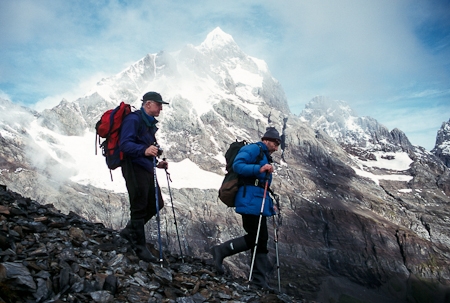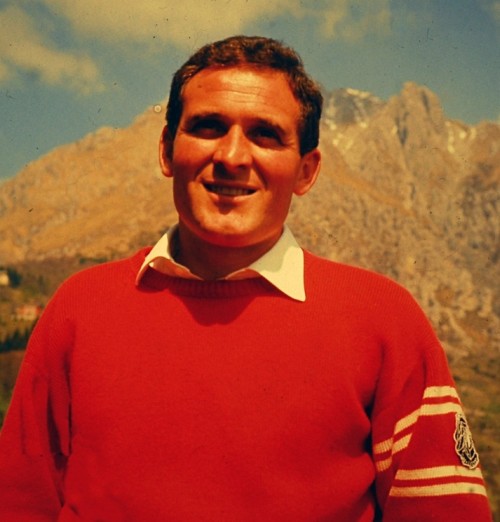|
The successful expedition Monte Buckland 2012 led us in January/February into one of the most inhospitable and least explored mountain ranges of the world: the Cordillera Darwin. Cordillera Darwin is located on the southern tip of the South American continent and is part of the archipelago of Tierra del Fuego. The highest mountains including Monte Darwin* (2.469 m), are located in the eastern part of the mountain range and have been climbed successfully in the 60s and 70s. Due to better accessibility from the starting point in Ushuaia (Argentinia) respectively Bahía Yendegaia (Chile) this part of the Cordillera is more often visited by expeditions than the western part. The western part of the Cordillera is almost unexplored. The main peak of Monte Sarmiento (2.246 m) saw until now only one successful ascent in 1956 (Maffei, Mauri). |
The primary objective of our expedition was to climb Monte Buckland (1.746 m). Nearby Monte Sarmiento, the mountain is situated on a remote peninsula only accessible by boat. Monte Buckland was successfully climbed in 1966 by an italian expedition, lead by Carlo Mauri, and was never visited again. Our team reached that fascinating summit by a new alpine-style north face route, further we ascended two minor peaks of the range formerly unclimbed. The constantly inconstant weather was without any doubt, besides the complex logistics and the orientation in the mostly unknown terrain, the biggest challenge within this expedition. * The mountain is also named Monte Shipton, in regards to its first ascent. The cited elevation varies between 2.469 m and 2.580 m asl. |
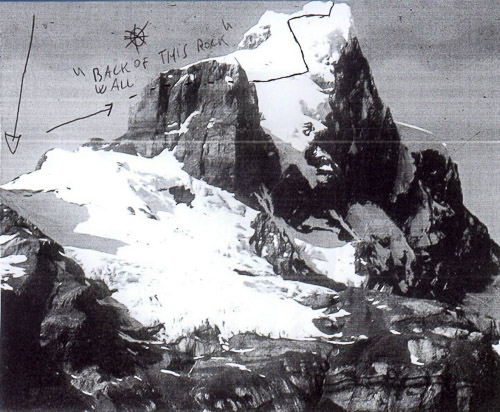 |
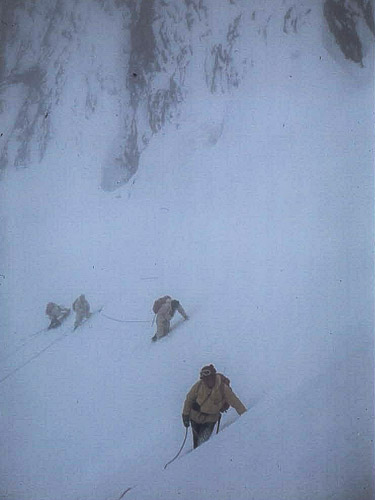 |
 |
 |
 |
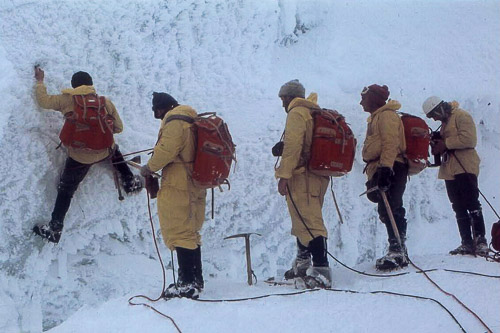 |
|
Until now we were sure that Buckland´s short climbing history was already told. But it was not! Investigations by Camilo Rada´s project “Uncharted — Cordillera Darwin” revealed that there was a non-published unsuccessful attempt of climbing Buckland´s virgin north face previous to our expedition! A team of well-known American climbing veterans formed by Jim Wickwire (*1940), John Roskelley (*1948) and Chris Kopczynski (*1948) – all of them experienced in several notable ascents in high altitudes worldwide – started the small expedition in late southern summer of the year 2000. Already five years before, Wickwire organized a successful expedition where Roskelley, Stephen Venables (GB) and Tim Macartney-Snape (AUS) made the 2nd ascent of Monte Sarmiento´s West summit by a new route. 
As Jim Wickwire told us, they approached with the help of a police helicopter directly to the western foot of Monte Buckland. Their planned route followed ramps and ledges in the lower north-west face up towards a hanging glacier, and then upwards to the obvious col in the north ridge (the location of our 2012 high camp). From there they hoped to gain access to the summit headwall although they have never found out for sure about the feasibility of the route above the col. From their base camp in the valley they got a “good view of the final few hundred feet, and it was very steep – easily 65 degrees, if not more, for the upper section to the summit ridge”. |
An estimate which turned out to be precisely accurate! However, rotten and greasy rockin the lower parts, and later on hard ice made it difficultjust to reach the col. Finally, the party had to retreat half way up the hanging glacier (approx. 950 masl.) without reaching the col. A second push was later prevented by bad weather and lack of time. After their expedition they concluded that “it is no surprise that this mountain has been climbed only once.” Thanks to the research of Camilo and the contribution of Jim, Buckland´s chronicle now counts on three expeditions in total: the first ascent via south-west face in 1966, the 2000 attempt, and finally our 2012 north face ascent.The time series of photos shows how the course of time impressively changes the aspects of the mountain. Glaciers retreat incredibly fast, ice gullies convert into mixed-climb challenges, icy flanks become bare (mostly bad quality) rock – in most cases this means enhanced difficulties and less protection for climbing. So maybe one day only winter conditions will be the appropriate ones to climb Plüschow´s Queen of Tierra Fuego. |
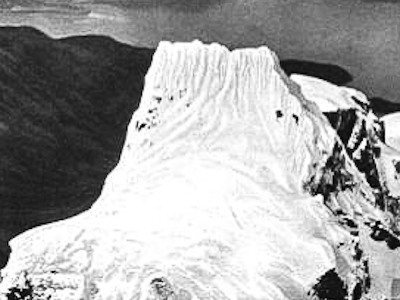 |
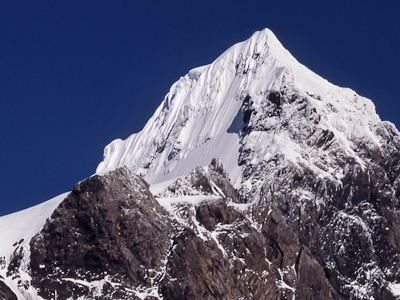 |
 |
|
Gigi Alippi, der bis dahin letzte noch lebende Teilnehmer an der Erstbesteigung des Monte Buckland im Jahre 1966, ist vergangene Woche im Alter von 80 Jahren in seiner Heimat Lecco (Italien) gestorben. Damit verliert die Ragni di Lecco einen ihrer prägendsten Protagonisten und die Welt des Alpinismus einen Pionier des Expeditionsbergsteigens. Zu seinen herausragenden Leistungen zählen – neben der Buckland-Expedition – die Teilnahmen an Erstbesteigungen wie die der gigantischen Südwand des Mount McKinley in Alaska (Cassin Ridge, 1961), der endlos steilen Eisflanke des Jirishanca in Peru (Westwand, 1969), des Huantsan-SW Gipfels ebenfalls in Peru (1972) sowie der lang umkämpften Cerro Torre-Westand in Patagonien (1974). Seine Seilpartner dabei waren u.a. die legendären Carlo Mauri, Casimiro Ferrari und Riccardo Cassin. Nach weiteren Expedition ins Himalaya (z.B. Versuch in der Lhotse-Südwand, 1975) war sein letzter großer Erfolg wiederum in der Cordillera Darwin: die Erstbesteigung des Westgipfels des Monte Sarmiento 1986. |
|
Ein wenig überraschend bekamen wir heute die Nachricht, dass unsere Expedition zum Monte Buckland im letzten Jahr auf der “Super Big List” des Piolet d’Or 2013 gelandet ist. Der Piolet d’Or ist quasi der Oscar des Bergsteigens und wird seit 21 Jahren von der französischen Zeitschrift Montagne Magazine in Zusammenarbeit mit dem französischen |
Extremalpinistenverband Groupe de Haute Montagne (GHM) vergeben. Mit dieser Auszeichnung sollen außergewöhnliche Leistungen im extremen Bergsport geehrt werden. Wenn man die Liste der 72 vorgeschlagenen Touren betrachtet, rechnen wir uns keine Chancen auf den Preis aus, aber stolz wie Bolle sind wir trotzdem!! |
|
















